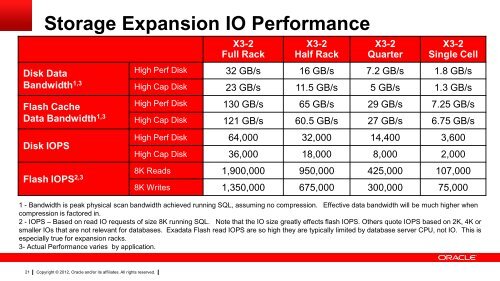Exadata Technical Overview - Oracle
Exadata Technical Overview - Oracle
Exadata Technical Overview - Oracle
Create successful ePaper yourself
Turn your PDF publications into a flip-book with our unique Google optimized e-Paper software.
21<br />
Storage Expansion IO Performance<br />
Disk Data<br />
Bandwidth 1,3<br />
Flash Cache<br />
Data Bandwidth 1,3<br />
Disk IOPS<br />
Flash IOPS 2,3<br />
Copyright © 2012, <strong>Oracle</strong> and/or its affiliates. All rights reserved.<br />
X3-2<br />
Full Rack<br />
X3-2<br />
Half Rack<br />
X3-2<br />
Quarter<br />
X3-2<br />
Single Cell<br />
High Perf Disk 32 GB/s 16 GB/s 7.2 GB/s 1.8 GB/s<br />
High Cap Disk 23 GB/s 11.5 GB/s 5 GB/s 1.3 GB/s<br />
High Perf Disk 130 GB/s 65 GB/s 29 GB/s 7.25 GB/s<br />
High Cap Disk 121 GB/s 60.5 GB/s 27 GB/s 6.75 GB/s<br />
High Perf Disk 64,000 32,000 14,400 3,600<br />
High Cap Disk 36,000 18,000 8,000 2,000<br />
8K Reads 1,900,000 950,000 425,000 107,000<br />
8K Writes 1,350,000 675,000 300,000 75,000<br />
1 - Bandwidth is peak physical scan bandwidth achieved running SQL, assuming no compression. Effective data bandwidth will be much higher when<br />
compression is factored in.<br />
2 - IOPS – Based on read IO requests of size 8K running SQL. Note that the IO size greatly effects flash IOPS. Others quote IOPS based on 2K, 4K or<br />
smaller IOs that are not relevant for databases. <strong>Exadata</strong> Flash read IOPS are so high they are typically limited by database server CPU, not IO. This is<br />
especially true for expansion racks.<br />
3- Actual Performance varies by application.

















